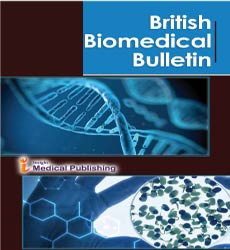ISSN : 2347-5447
British Biomedical Bulletin
Neuroinflammation and Cognitive Decline: Advances in Therapeutic Interventions
Ramesh Naer*
Department of Biotechnology, Indian Institute of Science, Bangalore, India
Corresponding author:
Ramesh Naer,
Department of Biotechnology, Indian Institute of Science, Bangalore, India,
E-mail: ramesh.nar@isc.in
Received date: January 02, 2025, Manuscript No. ipbbb-25-20755; Editor assigned date: January 04, 2025, PreQC No. ipbbb-25-20755 (PQ); Reviewed date: January 18, 2025, QC No. ipbbb-25-20755; Revised date: January 24, 2025, Manuscript No. ipbbb-25-20755 (R); Published date: January 31, 2025, DOI: 10.36648/2347-5447.13.1.85
Citation: Naer R (2025) Neuroinflammation and Cognitive Decline: Advances in Therapeutic Interventions. Br Biomed Bull Vol.13 No.1: 85.
Introduction
Neuroinflammation has emerged as a central pathological process underlying cognitive decline and neurodegenerative diseases, including Alzheimerâ??s disease, Parkinsonâ??s disease, and vascular dementia. Once considered a passive byproduct of neuronal damage, inflammation within the central nervous system is now recognized as an active driver of disease progression. Microglia and astrocytes, the brainâ??s resident immune cells, are pivotal in orchestrating neuroinflammatory responses through the release of cytokines, chemokines, and reactive oxygen species. While acute, controlled inflammation may serve protective functions such as clearing debris or pathogens, chronic and dysregulated neuroinflammation contributes to synaptic dysfunction, neuronal loss, and impaired neural circuitry, thereby exacerbating cognitive decline. Advances in molecular biology and neuroimmunology have enabled a deeper understanding of how neuroinflammatory cascades disrupt brain homeostasis, highlighting novel therapeutic targets for slowing or preventing cognitive deterioration [1].
Description
At the molecular level, the interplay between amyloid-beta aggregation, tau pathology, and neuroinflammation is particularly well documented in Alzheimerâ??s disease. Similarly, hyperphosphorylated tau tangles stimulate inflammatory pathways that amplify synaptic dysfunction and neurotoxicity. Beyond AD, in conditions such as PD, neuroinflammation in the substantia nigra contributes to dopaminergic neuron loss, while in multiple sclerosis; autoreactive T cells infiltrate the CNS and trigger inflammatory demyelination. Importantly, systemic inflammation-stemming from obesity, diabetes, or infections-can also cross-communicate with the CNS, worsening neuroinflammatory states and accelerating cognitive decline. These insights reinforce the view that neuroinflammation is not a singular phenomenon but a convergence of central and peripheral immune dysregulation, demanding therapeutic approaches that address both compartments [2].
Emerging therapeutic strategies aim to modulate neuroinflammation at multiple levels, ranging from upstream immune activation to downstream neuronal survival. One major avenue involves targeting microglial polarization. Microglia can adopt either proinflammatory or anti-inflammatory/neuroprotective (M2-like) states, or shifting this balance toward the latter has become a therapeutic priority. Experimental agents such as colony-stimulating factor 1 receptor inhibitors, P2X7 receptor antagonists, and modulators of fractalkine signaling are being investigated to recalibrate microglial activity. Anti-cytokine therapies, including inhibitors of TNF-α and IL-1β, also show promise in reducing neuroinflammatory cascades. Monoclonal antibodies and small-molecule inhibitors targeting complement pathways, particularly C1q and C3, are under development to prevent excessive synaptic pruning and neurotoxicity mediated by overactivated immune responses. These approaches collectively highlight the therapeutic shift from symptomatic management of cognitive decline to disease-modifying strategies rooted in inflammation control [3].
Parallel to immune-targeted therapies, lifestyle and metabolic interventions are gaining recognition as complementary strategies to attenuate neuroinflammation and promote cognitive resilience. Caloric restriction, intermittent fasting, and ketogenic diets have been shown to reduce systemic inflammation, enhance mitochondrial function, and improve neuronal plasticity. Exercise, in particular, induces anti-inflammatory cytokines such as IL-10, increases brain-derived neurotrophic factor, and enhances microglial homeostasis. Nutraceuticals, including omega-3 fatty acids, curcumin, resveratrol, and polyphenols, exert antioxidant and anti-inflammatory effects while supporting synaptic health. The gut-brain axis further represents a critical therapeutic frontier: modulation of gut microbiota through probiotics, prebiotics, and fecal microbiota transplantation can influence CNS immune activity, underscoring the systemic nature of neuroinflammation and its role in cognitive decline. These approaches emphasize the potential for integrative, non-pharmacological strategies to complement drug-based interventions [4,5].Conclusion
Neuroinflammation has shifted from being viewed as a secondary consequence of neurodegeneration to being recognized as a primary driver of cognitive decline. Advances in understanding the cellular and molecular underpinnings of neuroinflammatory processes have opened new therapeutic frontiers that range from immune modulation and metabolic interventions to cutting-edge genetic and nanotechnology-based therapies. While significant progress has been made, challenges remain in translating preclinical findings into effective clinical treatments, particularly given the heterogeneity of neurodegenerative diseases and the multifactorial nature of cognitive decline. Future directions will likely focus on developing personalized interventions based on biomarkers of neuroinflammation, integrating multi-omics data, and leveraging digital health platforms for monitoring cognitive outcomes. Ultimately, bridging the gap between mechanistic insights and therapeutic application holds the promise of transforming the prevention and management of neuroinflammation-driven cognitive decline, offering hope for millions of individuals at risk of or already living with neurodegenerative disorders.
Acknowledgement
None.
Conflict of Interest
None.
References
- Liu W, Deng W, Gong X, Ou J, Yu S, et al. (2025). Global burden of Alzheimer’s disease and other dementias in adults aged 65 years and over, and health inequality related to SDI, 1990–2021: analysis of data from GBD 2021. BMC Public Health, 25: 1256.
Google Scholar Cross Ref Indexed at
- d ‘Errico P, Meyer-Luehmann M (2020). Mechanisms of pathogenic tau and Aβ protein spreading in Alzheimer’s disease. Front Aging Neurosci12: 265.
Google Scholar Cross Ref Indexed at
- Kumar A, Singh A (2015). A review on Alzheimer's disease pathophysiology and its management: An update. Pharmacol Rep67: 195-203.
Google Scholar Cross Ref Indexed at
- Whelan J, Fritsche K (2013). Linoleic acid. Adv Nutr4: 311-312.
Google Scholar Cross Ref Indexed at
- Rett BS, Whelan J (2011). Increasing dietary linoleic acid does not increase tissue arachidonic acid content in adults consuming Western-type diets: A systematic review. Appl Physiol Nutr Metab, 8: 36.
Open Access Journals
- Aquaculture & Veterinary Science
- Chemistry & Chemical Sciences
- Clinical Sciences
- Engineering
- General Science
- Genetics & Molecular Biology
- Health Care & Nursing
- Immunology & Microbiology
- Materials Science
- Mathematics & Physics
- Medical Sciences
- Neurology & Psychiatry
- Oncology & Cancer Science
- Pharmaceutical Sciences
